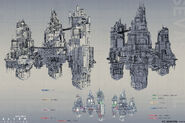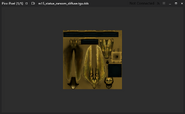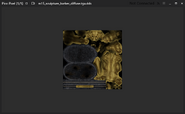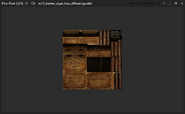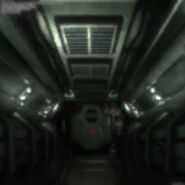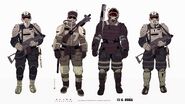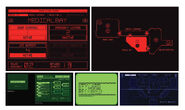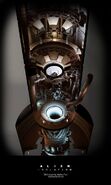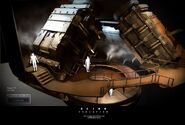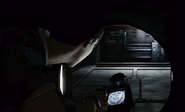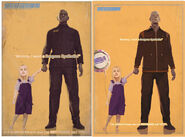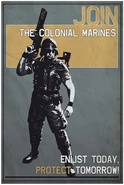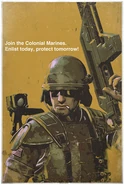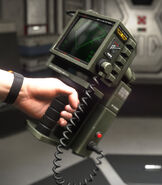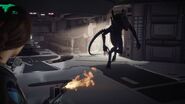This article covers the known cut content from the 2014 video game Alien: Isolation that does not constitute deleted scenes (story elements). This includes maps and environments that were removed from the game, including several with no obvious story purpose, as well as game features removed from the final product. This page also details how elements such as the user interface (UI) and gameplay mechanics changed during development. This information is sourced from leftover code in the game files as well as footage from pre-release events and early demos of the game — mainly the E3 demo and pre-alpha demo nicknamed "Showlevel".
Cut Archive Logs[]
Among the game's files are several audio logs that ultimately do not appear in the game. Transcripts of these logs can be read below. Logs are arranged here in the order they appear within the game's audio file directory — which is neither chronological nor necessarily the order in which the player would have collected them.
Locked Down Hospital (Lingard) - Audio
"Morley, this is Lingard. I've followed Waits' orders and locked down the hospital. If you need access to anything I've left details in my office – 232."
Terminal Riot (Julia Jones) - Audio (for alternate version)
"Julia Jones, journal entry 17th November. Oh my god, this is utter bullshit. Marshal god damn Waits finally called a public meeting, after our furious demands and the petition. The bastard said he was going to address the rumors that have been circulating on Sevastopol. 'Rumors'? What an asshole. Rumors don't kill people. Instead of giving us the answers we wanted, he continued to be evasive. The bastard's covering something. Anyway, everything went to hell. Waits and his thugs were pelted by projectiles from the crowd. Then someone fired a gun, for fuck's sake! I was screaming for them to stop. Jesus, we're all in this together, aren't we? There's talk of suing Seegson for mismanagement or corporate irresponsibility. Class action. Give me a damn pen. Where do I sign? And someone suggested taking that bastard Waits to a Colonial Marshal Service I.A. tribunal. Christ. In the Terminal, it was horrible. There was panic. I've never seen anything like it. I'm so afraid. Waits and his goons forcibly ejected us from the Terminal. Unbelievable. 'Protect and Serve'? What a joke. Feels like we're really on our own now. God, I'm so fucking scared."
Securing the Camp (Ricardo) - Audio
"Carter, it's Ricardo. Waits and I have put together a package for your camp in the tech stairway. Medical supplies – painkillers, antiseptic, bandages. There's some canned food, nothing that's gonna go bad. Finally – soap, water, toilet paper. Be careful, lots of crazies out there. Good luck."
The Signal's Clear (Marlow) - Audio
"That's it Taylor – it's letting me enter the Anesidora's co-ordinates. The signal's clear. This is Captain Marlow initiating the Anesidora's automatic recall systems. Code: Sigma Alpha Two Three Nine. Destination to follow."
Axel's Journal #331 (Axel) - Audio
"Axel's journal entry 331 – Excuse me if I lack my usual eloquence, but I woke up today with a pounding hangover. Last night I toasted the decommissioning of Sevastopol. No one else seemed to want to celebrate – pussies – so I was forced to drink the lion's share. Now, they say liquor loosens the tongue, even Sevastopol's piss-weak booze, and when I started cursing out Marshal Waits, a stranger staggered up to me and joined in. He was completely wasted, Drunk fucker kept saying he 'wasn't from these parts', but when I asked where he was from he put his finger to his lips and said he couldn't tell. Asshole. That's it, I'm going back to bed."
Awaiting Response (Taylor) - Audio
"Marshal Waits, this is Nina Taylor, from the Weyland-Yutani team assigned to collect the Nostromo flight recorder. We are yet to receive confirmation that you are prepared for our arrival on Sevastopol. I will be present to oversee the legal technicalities, along with a fellow executive and a colleague. The flight recorder contains proprietory company data. We understand Sevastopol is currently being decommissioned, but we trust the device's safety is of primary importance. Please respond as soon as possible."
Meeks, Pick Up (Heyst) - Audio
"Meeks, pick up. What the hell do you think you're doing? I know you were on the sauce last night, and once you get a few drinks in you your lips start flapping. You know that Marshal is looking for us, right? There's not that many people here and you start shooting your mouth off, he's going to find us. Marlow's already got picked up and I haven't heard from Foster at all. If you need to hit the booze, make sure you do it alone. Heyst out."
Journal Entry #333 (Axel) - Audio
"Axel's journal entry 333 – I fucking knew something was going down. I told them, but they just laughed it off. Well, they're not laughing now are they? To be fair, no-one is. I spent all last night wide awake, gun in my lap, twitching at the curtains. People are disappearing, and the word is Waits has been trying to keep it quiet. 'We are in control of the situation' – balls! There's a killer on the station and Waits knows who it is. Could even be one of his team. All I know is, I'm not staying another night. I'm getting someplace safer."
Dead Soldiers (Zach Watson) - Audio
"Well, here I am. Dry for a score and then Sevastopol happened. Happened to us all. Whole place has changed on me. Shifted. Nothin's right no more. Only thing to do is drop anchor in a bottle and get good and sunk. Killed a quart now and I still feel colder than a witches' tit. Still hearing things. What's out there? Here's to dead soldiers."
E3 2013 Demo[]
Alien: Isolation's story was heavily re-written around a year before its release, cutting a number of locations and changing story beats for some major characters. The UI for an early demo (presumed to be for the cancelled E3 2013 reveal) shipped with the final game, including a description of the demo's objectives, within the world of the original storyline.
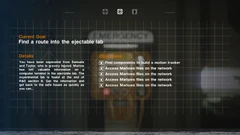
A screenshot of the old UI fixed up and working in-game.
The demo's description reads: "You have been separated from Samuels and Taylor, who is gravely injured. Marlow has left valuable information on a computer terminal in the ejectable lab. The experimental lab is found at the end of the R&D section B. Get the information and get back to the safe house as quickly as you can...". Two objectives can be seen: "Find components to build a motion tracker" and "Access Marlows files on the network".
Interestingly, a craftable motion tracker was the main focus of Alien: Isolation's CG trailer, created by Axis Animation prior to the story rewrite.
Cut Maps/Locations[]
The Patna[]
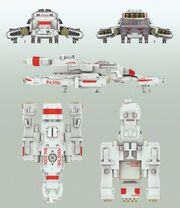
Concept artwork of the Patna.
A ship named the Patna (unrelated to the USCSS Patna from Alien3) was intended to appear in Alien: Isolation as a medical transport vessel, although it was cut from the final game. The exact role the ship may have played is unclear, although it is thought that it became the Solace, before being cut entirely. Concept art of the ship can be found within The Art of Alien: Isolation and references to the map file "BSP_Patna" can still be found in the final game. The ship was listed as containing basic infirmary, hypersleep and morgue facilities as well as featuring proportionally large engines, keeping the design in-line with Ron Cobb's original Alien aesthetic. At the center of the Patna was an exposed coolant chamber which would allow for the contents to be frozen for transit.
The Dry Docks[]

Concept art of the Dry Docks showing the Anesidora next to some Power Loaders.
Two maps are referenced in the game files for the Dry Docks - "ENG_DryDock" and "ENG_DryDockCargo". This is the location where Ripley and Marlow would have unsuccessfully tried to detonate the Anesidora and destroy Sevastopol in the original script of the game. Various pieces of concept art seemingly show views of this area from afar as well as one piece (to the right) showing an internal view of how large the space was. Seegson logos with the subtitle "Corporate Docks" also exist, possibly intended for the uniforms of the workers employed in this section of Sevastopol.
A window from this map is reused in the Tow Platform where Amanda goes to extend the maintenance rig near the end of the game. An ambient sound file can also be found in the game titled "AMB_Docks_Cargo", presumably intended for the ENG_DryDockCargo map. Additionally, the map "ENG_ReactorCore" (which contains Sevastopol's reactor core and the area surrounding it) references a script for the player entering the map "FromDryDockCargo". Activating this allows you to hear audio of the player arriving by a transit car, so it is possible that the Dry Docks were originally accessible by one of the now disabled transit points in the Reactor lobby. This is further confirmed by an ambient sound reference titled "AMB_DryDock_Transit". Further ambient sounds for the Dry Docks reference "Umbilicus", "Vent" and "Transit_Control_Room", so it is likely that these were the main areas found within the map(s).
The map "ENG_DryDockCargo" was seemingly repurposed to create the areas in the lower sections of the "HAB_Airport" map in the final game, where the player visits Axel's den and encounters some other survivors. Scripts for this section are referenced as "cargo". The AYZ Sevastopol map also places these locations close together, which is possibly why the maps were merged. The elevator ride with Axel is likely what would have originally triggered the load of the DryDockCargo map before they were merged.
Cooling Plant and Waste Management[]
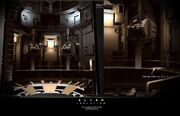
Concept art of the waste chute (more in the gallery at the bottom of this entry).
The Cooling Plant and Waste Management sections of Sevastopol, located on the Engineering decks, were seemingly to be a playable environment, spread over three separate maps. The relevant sectors of the station are labelled on a schematic of Sevastopol that was drawn early in development, when the game was still known as Alien Year Zero. The game's files refer to maps named "ENG_WasteChute", "ENG_WasteManagement" and "ENG_CoolingPlant". Although the reasons behind the removal of these maps is not known, it is likely due to the massive change of story prior to the game's release. Since these locations are labelled on the map of Sevastopol, referenced in the final game's map list and also shown in concept art, we can assume that these sections made it quite far into development even though very little is known about them. It is believed that the Cooling Plant would have been accessible from the map ENG_ReactorCore, as that map has a script to handle the player entering "FromCoolingPlant". This script can be activated, and triggering it places the player underneath the elevator that they arrive in from APOLLO (TECH_MuthrCore).
The "relay" section of the second Salvage Mode DLC map seems to use the waste chute concepts heavily in its design.
The Gravity Anchors[]

Concept art of the gravity anchors.
A large amount of concept art was produced for the Gravity Anchors area of the station and The Art of Alien: Isolation details some more information about the anchors themselves. Additionally, a reference can be found within the game files to a map directory (removed in the final build of the game) for "ENG_Gravity_Anchor". The game classifies each section of Sevastopol with a different prefix, the Gravity Anchors receiving the "ENG" prefix for Engineering as they were located at the bottom of Sevastopol. Due to the map being referenced within the final build of the game, along and all the concept art available online, it is assumed that this section of the game made it quite far into development. A number of sound files can also be found in the game for this mission/map.
Comms array catwalks[]

Seegson Communications Comms Array whitebox.
Early whitebox concepts for the external communications array found within Seegson Communications show extensive catwalk sections on the exterior of Sevastopol, something which is not found within the final game. These catwalks completely surround the communications dishes and have multiple levels accessible by ladders. Of course, the use of ladders while in a spacesuit is ridiculous and is not present in the final game, replaced by an elevator in sections where the catwalk is multi-storey.

Presumed Tow Platform whitebox.
Another whitebox concept shows what is presumed to be the exterior of the Tow Platform where Amanda boards The Torrens at the end of the game in mission "SHOWDOWN". This again has extensive catwalk sections and is multi-storey accessible via a ladder. The levels are marked with large numbering, something which is seen a lot in early game prototypes and concept art, but used less in the final product.
Transit Shuttles[]
Although only seen briefly when flying to the Anesidora in the final version of Alien: Isolation, transit shuttles were originally planned to be a more significant part of life on Sevastopol, with shuttles required to reach the Executive Suites (requiring a personal keycard to access and operate). The cut mission "M15" would have seen Amanda use the transit shuttles, and while this isn't present in the final game, an animation previs can be seen showing what the sequence would have looked like - as well as an initial storyboard design for the sequence. Two loadscreen cutscenes can also be found in the game files showing the shuttles transiting between Sevastopol's towers. It is likely (and also hinted at through leftover codenames in the shipped version of the game) that the SHUTTLE cutscenes replaced this animation previs in "M15" to allow the new map to load during the transition.
Amanda does use an inter-tower transit shuttle in the final game however it lacks the extended animation seen in the designs and previs below. This is likely what came from the intended implementation in M15, although more basic than planned.
Cut Game Features[]
Multiplayer[]
Alien: Isolation was originally intended to feature a multiplayer and co-op component, however these modes were cut from the game following a review by SEGA after the poor reception of Aliens: Colonial Marines. Notably, in 2012 Creative Assembly were hiring for a multiplayer and network programmer, specifically to work on the project that would become Alien: Isolation, utilising the NetZ library which is still referenced in the game's files.[1][2] When the game first leaked over Xbox Live, the store listing also specified 1-4 player co-op/multiplayer functionality. It's not known when the multiplayer modes were scrapped, but it seems to be related to the story rewrite which happened around the beginning of 2013, causing the game to be delayed from its initial planned announcement date at E3 2013.
A large amount of networking references exist within Alien: Isolation's binary, showing support for client hosted game sessions and networked player entities with physics support. Cathode scripting nodes exist in the final game for multiplayer functionality, including:
- NumConnectedPlayers
- NumDeadPlayers
- NumPlayersOnStart
- ParticipatingPlayersList
- SyncOnAllPlayers
- SyncOnFirstPlayer
- AllPlayersReady
- NetPlayerCounter
- NetworkedTimer
- FilterIsLocalPlayer
- IsMultiplayerMode
A PvP object marking system for alerting players in the lobby of weapons and dangers is referenced in the game, along with sounds under the state name of Multiplayer_Communication_Type, with individual states within that for:
- Run
- None
- Good_Job
- Equipment_Here
- Quiet
- Use_that
- Look_there
- Wait
- Come_To_Me
- Thanks
- Hello
- Hurry_Up
- Alien_Spotted
Presumably these sound events would act as pre-set communication between players along with the marking system.
A respawning system exists to respawn players with allegiance groups at set points over intervals depending on the number of players left alive. A networked egg spawning system is referenced with a hostility option. It's thought this multiplayer functionality could also be linked to ALIEN_PLAYER (see "A Playable Xenomorph"), with the allegiance groups being survivors and aliens. The PvP object marking system seems to tie with the Crew Expendable DLC, which is nicknamed TwoTeams in the game files. It is possible that before the Alien cast were brought on to the project, players could play the DLC online cooperatively. Regular mentions are also made in the binary for "Player2", alongside the game's Character_Type audio state containing sound sets for Player1 and Player2.
General gameplay mechanics[]
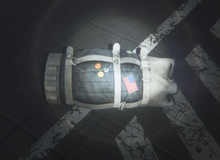
A screenshot of the death "mori marker" as it would have appeared in-game.
A feature known as "Memento Mori" would have allowed players to leave items or messages for other players to see in the game world, similar to the systems found within Dark Souls. The feature could be toggled on or off while playing, and although cut from the game the model of the Memento Mori bag that would contain the items, scripts for "morimarkers" on death, and the code for the settings to disable it can still be found in the final game's files.
Another removed feature was a "New Game+" mode, likely unlocking additional difficulties or features for a second playthrough, although very little is known about the specifics. Novice and Nightmare mode were added in a patch post-launch, able to be selected on first playthrough. These modes may have originally been intended to be unlocked through "New Game+".
The game also originally featured more variety in the arcade machines seen in mission 2, when Amanda first enters the Spaceflight Terminal and goes to Cred-Op Amusements to restore power. The game's files contain jingles for three unused arcade games titled "Power Up", "Dinky King" and "Super Mooria", the latter two obvious puns on the classic video games Donkey Kong and Super Mario. Additionally, a jingle and a large number of in-game sound effects can be found for another arcade game called "Dragon Gauntlet"; the sound files seem to indicate that this was a fighting game akin to Street Fighter, while the name "Dragon Gauntlet" is presumed to be based on an item available in Runescape that grants improved melee abilities.
Additionally, the player was originally able to zoom the flashlight in and out, but this feature was removed from the game in favour of an average-sized fixed beam. This could have been in an attempt to simplify the control scheme. References to this feature and sound effects for the zoom ability can still be found in the game files, as well as being present in the game's announcement demo "showlevel".
Third Person Gameplay[]

Alien- Alien Isolation 3rd Person Demo
A video of the game when it was third person.
Originally Alien: Isolation was a third person experience using a cover and traversal system to allow the player to hide from the Xenomorph. The game was later changed to become a first person experience, with lockers effectively replacing the third person object cover system. It's not known how late into development this switch happened, but a video of the game running in this third person state can be seen and it is clear that the game is far into production, with a lot of final assets in place including props and environment assets which are identical to that of the shipped version of Alien: Isolation. This third person demo video is apparently internally named "IL3", and was at a point where the game was still called Alien Year Zero - believed to be early 2013. Some environments from the IL3 build made it to the final game, including the offices around the reactor core.
A number of references to the third person mechanic are still present in the final game including the definitions for the cover and traversal system. The original third person camera system can be re-enabled by tweaking the game's GAMECAMERASETTINGS flowgraph. The developers explained that their choice to move to a first person experience was to immerse the player in the world of the game, however it is potentially tied to SEGA's review of the project following Aliens: Colonial Marines which led to the removal of multiplayer and a story rewrite.
A playable Xenomorph[]

A section of code from "ALIEN_PLAYER.BML", the behaviour settings file for the player controlled Xenomorph.
Multiple references can be found in the files to a point in development where Alien: Isolation featured a playable Xenomorph. While this is potentially tied to the cut multiplayer components as explained in the "Multiplayer" section, it is likely that the playable Xenomorph was more intended for testing gameplay.
In the PC game's debug settings, it is found that a programmer could opt-in to manually control survivors, Working Joes and the Xenomorph. This is further expanded upon in files found within the console build of the game, where two files can be found named "ALIEN_PLAYER" and "ALIEN_TEST" which are not present in the PC release. These behavior settings specify a second player having the ability to control a Xenomorph, with the first player controlling Amanda. The Xenomorph had 1,500 health points compared to Amanda's 1,000 health points and an ability to peek around corners like Amanda, but with a vastly reduced range — only being able to move 45% of Amanda's horizontal peeking and 25% of Amanda's vertical peeking.
Craftable items[]

A comparison of the item icon and name changes.
The player's inventory has slots for both small and large medkits, the latter of which was cut from the game. The large medkit would have restored all of the player's health when used, as opposed to just a percentage of it. Four other cut craftable items referenced in the game files are known as "chem_light", "wide_area_chem_light", "explosive_mine" and "incendiary_mine". The inventory also references a mission-specific item called the "Oscillator". Oscillators are used to create electronic signals which can be output as sound — therefore it is possible that the "Oscillator" was simply an early version of the noisemaker. Close to release the names of crafting components and their in-game icons were also changed for an unknown reason.
Craftable weapons and ammo[]

Old inventory icons.
An early intention for the game was to be able to craft/combine weapons and ammo, rather than acquire them just through regular pickups as you do in the final game. The UI for this system shipped with the final game through the game's hub menu (the tab map screen) however is not entirely accessible ("HUB_CONSTRUCT.GFX" and "HUB_INVENTORY.GFX"). This used a system similar to that of the item crafting found in the radial menu in the final game. Combining collected components in your inventory would produce things such as tazer pistols. Assets exist for some cut pickup item inventory icons (seen to the right). As well as combining items in your inventory, it seems that you could also drop items, similar in style to Fallout or similar games. Commands still exist in the UI external interfaces for all of this functionality. In an earlier version of the game, instead of simply being able to access this functionality through the hub menu, the player would have to visit crafting workbenches - similar to Dead Space 3 - in order to combine components to upgrade weapons. This functionality can be seen in the extended cut of the game's IL3 demo, first premiered on the NoClip YouTube channel.
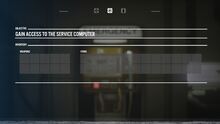
A screenshot of the inventory UI fixed to work in-game. The icons above would show in these slots, with options to inspect or drop.

A screenshot showing the game's original 3rd person build with the weapon crafting UI.
UI changes[]
A number of changes were made to the game's user interface (UI) close to release, specifically the motion tracker interface, HUD and "hub" menu.

The original motion tracker interface, as seen in the pre-alpha demo.
The original design of the motion tracker UI was similar to what is seen in the final game, however it was lighter and didn't fade towards the edges of the screen. More film grain was applied and the tracking dot was slightly different to the final game, with the pre-release dot being solid white and seemingly updating more frequently than the final game's dot with blurred edges. According to a developer, these changes were made to the motion tracker due to performance drops with the original design.

The pre-release "hub" screen.
A number of large changes were also made to the "hub" screen (where the level map can be viewed), with additional tabs allowing the player to check audio logs, inventory and more. In the pre-release demo this screen also had a blue tone with more of a mechanical "blueprint" feel, whereas in the final game this screen is a lot darker with a flatter design and a semi-transparent background. The tab for accessing the inventory menu can be seen in the release game files, although is not accessible within the game. Notably, in the screenshot of the original map design in the hub (to the right), the "KG-348 Research Labs" are named "Prophesys Research Labs".

Pre-alpha HUD, E3 HUD, final HUD.
The original HUD was also modified late in development, switching the rounded HUD bar seen in pre-release demos to blocks of information as seen in the final game. Interaction prompts were also changed from red to green, and objective popups were changed to match the style of the new hub design.
An old version of the hub menu's log screen can be found in the shipped files, with some comical placeholder logs of:

A screenshot of the old log screen fixed to work in-game.
Chapter 1:
- DISTRESS CALL - PATNA
- HYPERSLEEP GUIDE
- TORRENS LOG / VERLAINE 01
- VERLAINE ID
- SAMUELS PITCH
- TORRENS LOG / VERLAINE 02
- MY FIRST DRAWING
- TORRENS LOG / SAMUELS 01
- TAYLOR - CREW PITCH
- CREW PHOTO 01 - TORRENS
- MY FIRST TEXT LOG
Chapter 2:
- DAVE GOT EATEN BY ALIEN
- JEFF GOT EATEN BY ALIEN
Chapter 3:
- LOTS OF NUMBERS BECAUSE WE DO SCIENCE
- RARRRRRR
- NOW I TALK ABOUT LOVE OR SOME SHIT
- WE KILLED SPACE JESUS
Chapter 4:
- I LIKE THE BEEPY NOISES
- HORSES IN SPACE
- ANDROID GETS HAPPY-SLAPPED LOL
Sevastolink terminals[]

The early Sevastolink design.
In pre-release screenshots (and potentially also some game demos) of Alien: Isolation, the Sevastolink terminals (manufactured by Karnak) have a different design to the ones seen in the final game. They feature an alternate keyboard design and seem to have a different style of user interface. This original interface seems to be black and white, whereas the interface in the final game is based on shades of green and white. The original terminal design can be seen in the KG-348 Research Labs where there is a prop computer that the player cannot interact with that uses the original model. Notably, this computer doesn't hold the Karnak logo like the final Sevastolink terminal design does.
Working Joes[]

A comparison of the pre-alpha and final Working Joe model seen in the KG-348 Research Labs.

Working Joe concept art.
Similarly to the Sevastolink terminals, the Working Joes also featured a different design in earlier versions of the game. In the Pre-Alpha Demo (nicknamed "Showlevel") the Working Joes seen dead in the KG-348 Research Labs feature a more human facial design compared to the mannequin-like look in the finished game. In early revisions of the in-game posters, this original Working Joe design is also seen. The androids hold a clearly more human-like appearance although still being fully white skinned. The developers stated that they went for a very robotic appearance for the Working Joes to allow the player to easily identify them as a different character to other survivors on the station, hence the change of character model.
Further human-like variants of the Working Joes were experimented with (see right) which featured hair and hats. Again, these were removed from the game likely for the same reason, and likely also because they look less menacing with long hair and a baseball cap! Check out comparisons of the pre-release posters and final game posters in the gallery at the end of this article to see the changes to the art. Interestingly the original Working Joe poster art shows them with a name badge and the Weylan-Yutani logo on their chest. It is possible that Working Joes were not originally planned to be manufactured by Seegson.
Amanda's backpack[]
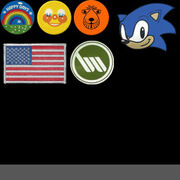
The texture for Amanda Ripley's bag, showing the Sonic logo which was hidden in the final game.
At some point in development, Amanda had a Sonic the Hedgehog keychain hanging from her backpack. It can still be seen in the bag_details texture (shown to the right), and other development character art shots.
Bonus content[]

A screenshot of an early "crash test dummy" build of the game from around 2012.
In the finished game, the "Extras" tab on there main menu simply contains an option to re-watch the game's end credits, but the UI files for the menu indicate there were originally to be several additional options, including "Image Gallery", "Dev Diaries" and "Achievements and Progress". Selecting "Dev Diaries" would have allowed the player to view three sections named "Making of Alien: Isolation", "Deleted Scenes" and "CG Trailer". It's not known why these features were removed from the game. The original main menu used for the pre-alpha demos also included a splash-screen for Cathode, the custom engine that the game runs on. No mention of Cathode is seen in the final build of the game, however it is referenced on the store page.
Virtual Reality mode (VR)[]
Teased at various gaming conventions before the release of Alien: Isolation, a VR mode was in development that would have allowed players to experience the game on Oculus and PSVR. While the VR mode was playable at a number of events, the developers commented that they considered it only a demo, and were unsure the full game would ship with the functionality. Shortly before release it was confirmed that the VR mode had officially been scrapped.
Following the release of the game modders discovered that it still included support for Oculus DK1, which could be re-enabled by changing a configuration file. Official PSVR support was never mentioned, however code for it can be found within the game files. It's unknown why the VR mode was scrapped, but the cause was likely either financial (SEGA refusing to fund extra development time) or technical (the systems and mechanics that would need to be reworked).
As well as VR, options for stereoscopic and anaglyph 3D modes are seen in the same configuration file to enable Oculus support. This functionality was also scrapped.
Trivia[]
- Multiple pieces of music were compsoed for the game's main menu, each with a different mood. The development team then voted on which one they liked best, with the winner being used in the finished game. One rejected piece was similar to the music used in the survivor mode DLC packs, with an eerie piano backing. This theme was seemingly not shipped with the game.
- An SMG was a late-removed weapon for the game, with its magazine pickup still being feature-complete within the game files, along with FX for firing.
- The game's engine (known as Cathode) is based upon a highly modified version of the engine used for 2008's Viking: Battle for Asgard.
- The game was prototyped using character models resembling crash test dummies before the final characters were decided upon. This early dummy phase of development was seen in the background of an office photo in February 2012, and is shown in The Art of Alien Isolation book.
- The working title for Alien: Isolation was Alien Year Zero. This name was used from the original greenlight demo through the game's development, often referenced in filenames. Publicly the title was never used.

A screenshot of the Xenomorph in Alien: Isolation's early whitebox testing.
- The development team noted that the typical "whitebox" model of prototyping game mechanics didn't work for Alien: Isolation. It was only when they added basic lighting and sound that the character had the effect they were looking for.
Gallery[]
References[]
See Also[]
- Alien: Isolation deleted scenes — A list of deleted scenes from the game.
- Alien: Isolation maps — A list of maps used in the game, including the known unused maps.
- Alien: Isolation missions — A list of missions in the game's campaign, including the known unused missions.
- Alien: Isolation cutscenes — A list of cutscenes in the game's campaign, including known removed scenes.





